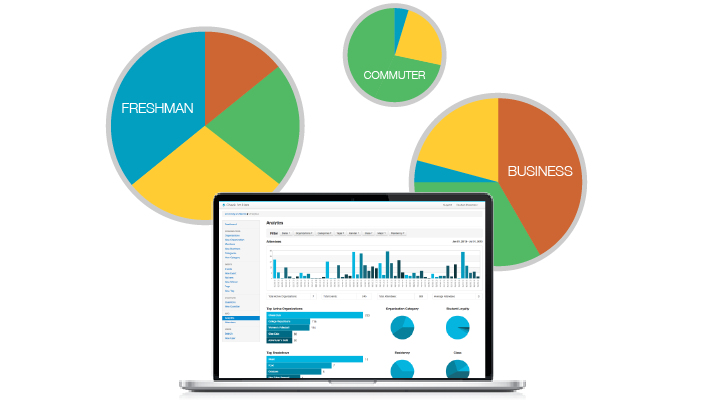When it comes to planning and organizing campus programs, you want staff and students who are passionate about working on it every step of the way.
Institutions are starting to quantify the student life experience and truly understanding the impact of face-to-face interactions through well-organized, engaging, and timely campus life events.
Student engagement software platforms are now highly coveted technology tools that make collecting data easier than ever and help assign value to campus life events.
“Technology can become the ‘wings’ that will allow the educational world to fly farther and faster than ever before- if we will allow it.”
Institutions need multiple ways to measure the return on investment (ROI) for various events. Data-driven technology allows student affairs professionals to triangulate data and understand where time needs to be spent most.
Many professionals have an intuitive sense or ‘feeling’ if campus event performs well. A huge group of students attended, the food is gone at the end of the night, and social media is poppin’. This year, institutions are tightening their budgets as they prepare for FLSA and intuition is no longer enough – if campus events are a large part of expenses, administrators need to know they create a positive impact among student life. Why would an office or organization continue to plan activities that don’t have a positive impact among students?
We’ve outlined steps for you to follow to ensure your event is worth the cost and feel confident in showing an event’s ROI.
Step 1: Focus on Specific Outcomes
Events and programs, whether large or small scale, co-sponsored or not, aim to meet the overarching goals of a campus engagement strategy.
The first step to a clearer picture is delineating specific event objectives and/or learning outcomes to identify how an event directly impacts students.

You don’t need to be Sheldon to explain the benefits of creating outcomes and tracking involvement for each event.
When an organization submits a proposal to allocate money or resources for a campus program, objectives and learning outcomes should be clearly stated. This can help the organization, for instance, Student Government make a grounded decision around funding other student clubs.
For example, at the beginning of the year, your group sets a goal of reaching and getting a certain percentage of first-year students to attend a specific number of fall events. You determine that in order to reach that goal, you must understand how to better market and communicate to first-year students. As an advisor, you know you can’t just tell the club or organization to just ‘do it better’, you need to equip them with motivation and tools of how to actually accomplish the goal. The objective(s) of the event would be to demonstrate the importance of reaching first-year students and giving students skills to reach their potential.
Questions to reflect on if you’re group is struggling to think of objectives may include:
Are we…
Including diverse student groups in our engagement strategy?
Brainstorming new ways to reach uninvolved students?
Having repeat students attend events? If so, how have we captured their attention?
Being intentional with aligning outcomes helps each individual reflect thoughtfully in the planning and organization process. This also creates more buy-in with students because they want to see their peers have a positive, meaningful experience on campus.
Step 2: Incorporate Social Media KPIs
Key Performance Indicators or KPIs will help your team get to where they need to be in terms of connecting with students on social media platforms.
Students consume more content than ever, and you need to be able to understand your event’s reach with the campus population.

Metrics are used to identify which platforms work best for spreading the word and determine which are truly worth the time. In some cases, if you’re launching a new platform (like Instagram) and want to know if the launch was successful, you can monitor things like engagement rate (we use Buffer) or link clicks (snip.ly or bit.ly).
Here are social media metrics that could be used with the main goals or objectives of your event:
- Objective: Raising awareness of event
- Metrics: Pre- and post-awareness levels, social media mentions
- Objective: Generating interest from diverse groups of students
- Metrics: Tracking students at the event, identifying groups of students who attend through technology
Say your group identifies that they could improve their reach by posting on social media at different times of the day. A discussion or training with your student group may include:
- Tips, tricks, and tools to schedule social media
- Effective ways to market and spread the word as a student leader
- Fostering trust with the campus community to increase engagement
Along the same lines, while interacting with students in-person, you must remember the reach of the event is not confined to the event itself. If the event or program is worth talking about, attendees will be motivated to tweet, post pictures, or share their opinions via social media.
Step 3: Take Action with Data
Collecting data from events is a key way to understand where to focus efforts in terms of marketing, engagement, and creating a positive, impactful experience for students.
Using a student engagement platform will help you track specific metrics (i.e. student attributes like how many second-year students attended the event? Why was there a low percentage of students who attended that identify as commuters and are business majors?) Providing data points to help you determine the success of the event and ways to improve the next.

By constantly measuring, taking action, and providing feedback, your team optimizes events and improves ROI. When sharing metrics and showing progress to campus stakeholders, it’s important to show the bad with the good, and celebrate successes and progress made towards the main objectives or goals (if not, you will have clear indicators of how to experiment and change them).
Showing the success of an event in terms of dollars isn’t always the easiest thing to do, but you can (and should) clearly define and communicate objectives, goals, and metrics to monitor progress and improve.
Your Thoughts!
Humans are prone to falling back into old habits easily if they don’t have an incentive to understand their true impact. Setting goals and outcomes, keep track of metrics, and reporting back to your group in a timely and consistent manner will help expand an organization’s reach and impact students in profound ways.
Dr. Ann Marie Klotz reinforces this notion,
“The measure of a successful person is based on their ability to persist, deliver and achieve–every single time. I’m not interested in talking about accomplishing goals–I’m focused on the execution and actually doing it.”
Share your thoughts and successful event-planning habits with us @CheckImHere. Thanks for reading!





